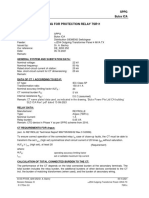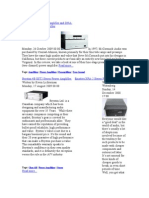Oil Filled Cables
Oil Filled Cables
Uploaded by
Xen Operation DPHCopyright:
Available Formats
Oil Filled Cables
Oil Filled Cables
Uploaded by
Xen Operation DPHOriginal Title
Copyright
Available Formats
Share this document
Did you find this document useful?
Is this content inappropriate?
Copyright:
Available Formats
Oil Filled Cables
Oil Filled Cables
Uploaded by
Xen Operation DPHCopyright:
Available Formats
oil-filled cable (electricity)
Cable having insulation impregnated with an oil which is fluid at all
operating temperatures and provided with facilities such as longitudinal
ducts or channels and with reservoirs; by this means positive oil
pressure can be maintained within the cable at all times, incipient voids
are promptly filled during periods of expansion, and all surplus oil is
adequately taken care of during periods of contraction.
McGraw-Hill Dictionary of Scientific & Technical Terms, 6E, Copyright © 2003 by The McGraw-Hill Companies, Inc.
Oil-Filled Cable
a high-voltage power cable in which the paper insulation is
impregnated with mineral oil under pressure. An increase in the
electric strength of insulation is achieved in oil-filled cables through the
elimination of gas inclusions (voids) within the insulation, which are
potential sites of breakdown, by filling them with oil. During operation
of the cable the oil pressure is maintained by make-up equipment. Oil-
filled cables are used to lead power lines from large power plants or
underground hydroelectric power plants to distribution equipment,
where power transmission lines cross water obstacles, in densely
builtup areas, and where power lines extend far into cities with high
power consumption.
Two types of oil-filled cable are manufactured in the USSR.
The first type is a single cable with a centrally located oil channel, with
the oil under low or medium pressure (0.1-0.3 meganewtons per sq m
[MN/m2]).
The second type is a multicore high-pressure cable (1.4-1.5 MN/m 2).
The first type has a conductor with a cross section of 150-800 sq mm
made of tinned, shaped copper wires arranged in concentric layers.
The channel diameter is usually 12 mm for cables of any cross section;
it is formed by twisting the wires of one layer. The insulation of an oil-
filled cable consists of oil-impregnated high-voltage cable paper
(sometimes calendered); the electric strength of the oil is not less than
180 kilovolts per cm (kV/cm). The insulation is separated from the
strand and the metallic sheath by a screening layer of semiconducting
paper. Sometimes the outer screen is supplemented by copper or
aluminum foil. The lead sheathing is usually reinforced by a hard-rolled
copper ribbon. The use of aluminum sheathing substantially decreases
the cost of oil-filled cable and also reduces its weight. However, the
aluminum sheathing must be corrugated to make it flexible, and it also
requires increased protection from corrosion. Single oil-filled cable is
most frequently used for voltages from 110 to 220 kV.
In multicore high-pressure oil-filled cables the insulated, circular
multiwire conductors have no inner channel; they are arranged in an
oil-filled steel pipe with a diameter of 220 to 270 mm. The paper
insulation and the cross sections of the strands are the same as those
of single cable, but the electric strength of insulation is considerably
higher than in low-pressure oil-filled cables. The steel pipe is protected
on the outside by corrosion-resistant coatings. The cable is assembled
directly at the cable run. The pipeline is welded together from sections;
the insulated conductors are delivered from the factory in a lead
sheath, which is stripped when the conductors are pulled into the pipe.
After completion of the laying operations, oil is pumped through the
pipeline a number of times until the desired electrical characteristics
are produced. High-pressure oil-filled cables are used for voltages
from 220 to 750 kV. Forced cooling of the cable is desirable for
voltages above 500 kV; such cooling is achieved by circulating cooled
and purified oil through the pipeline.
In the USA and Japan, and in several European countries, oil-filled
three-core cables are manufactured for voltages from 60 to 110 kV,
with conductor cross sections from 80 to 325 sq mm. The conductors
are arranged in a straight line (flat cable) or around the circumference.
Oil-filled cables are noted for their high reliability and ability to
withstand prolonged overloads, as well as for the stability of the
electric strength of the insulation.
You might also like
- The Subtle Art of Not Giving a F*ck: A Counterintuitive Approach to Living a Good LifeFrom EverandThe Subtle Art of Not Giving a F*ck: A Counterintuitive Approach to Living a Good LifeRating: 4 out of 5 stars4/5 (6018)
- The Gifts of Imperfection: Let Go of Who You Think You're Supposed to Be and Embrace Who You AreFrom EverandThe Gifts of Imperfection: Let Go of Who You Think You're Supposed to Be and Embrace Who You AreRating: 4 out of 5 stars4/5 (1113)
- Never Split the Difference: Negotiating As If Your Life Depended On ItFrom EverandNever Split the Difference: Negotiating As If Your Life Depended On ItRating: 4.5 out of 5 stars4.5/5 (909)
- Hidden Figures: The American Dream and the Untold Story of the Black Women Mathematicians Who Helped Win the Space RaceFrom EverandHidden Figures: The American Dream and the Untold Story of the Black Women Mathematicians Who Helped Win the Space RaceRating: 4 out of 5 stars4/5 (937)
- Grit: The Power of Passion and PerseveranceFrom EverandGrit: The Power of Passion and PerseveranceRating: 4 out of 5 stars4/5 (619)
- Shoe Dog: A Memoir by the Creator of NikeFrom EverandShoe Dog: A Memoir by the Creator of NikeRating: 4.5 out of 5 stars4.5/5 (546)
- The Hard Thing About Hard Things: Building a Business When There Are No Easy AnswersFrom EverandThe Hard Thing About Hard Things: Building a Business When There Are No Easy AnswersRating: 4.5 out of 5 stars4.5/5 (358)
- Her Body and Other Parties: StoriesFrom EverandHer Body and Other Parties: StoriesRating: 4 out of 5 stars4/5 (831)
- Elon Musk: Tesla, SpaceX, and the Quest for a Fantastic FutureFrom EverandElon Musk: Tesla, SpaceX, and the Quest for a Fantastic FutureRating: 4.5 out of 5 stars4.5/5 (479)
- The Emperor of All Maladies: A Biography of CancerFrom EverandThe Emperor of All Maladies: A Biography of CancerRating: 4.5 out of 5 stars4.5/5 (275)
- The Little Book of Hygge: Danish Secrets to Happy LivingFrom EverandThe Little Book of Hygge: Danish Secrets to Happy LivingRating: 3.5 out of 5 stars3.5/5 (434)
- The World Is Flat 3.0: A Brief History of the Twenty-first CenturyFrom EverandThe World Is Flat 3.0: A Brief History of the Twenty-first CenturyRating: 3.5 out of 5 stars3.5/5 (2281)
- The Yellow House: A Memoir (2019 National Book Award Winner)From EverandThe Yellow House: A Memoir (2019 National Book Award Winner)Rating: 4 out of 5 stars4/5 (99)
- The Sympathizer: A Novel (Pulitzer Prize for Fiction)From EverandThe Sympathizer: A Novel (Pulitzer Prize for Fiction)Rating: 4.5 out of 5 stars4.5/5 (125)
- Devil in the Grove: Thurgood Marshall, the Groveland Boys, and the Dawn of a New AmericaFrom EverandDevil in the Grove: Thurgood Marshall, the Groveland Boys, and the Dawn of a New AmericaRating: 4.5 out of 5 stars4.5/5 (273)
- A Heartbreaking Work Of Staggering Genius: A Memoir Based on a True StoryFrom EverandA Heartbreaking Work Of Staggering Genius: A Memoir Based on a True StoryRating: 3.5 out of 5 stars3.5/5 (233)
- Team of Rivals: The Political Genius of Abraham LincolnFrom EverandTeam of Rivals: The Political Genius of Abraham LincolnRating: 4.5 out of 5 stars4.5/5 (235)
- QSB6.7 CM2250 Marine 4310614Document1 pageQSB6.7 CM2250 Marine 4310614ICHAC75% (4)
- Occupation Questionnaire: Tataaia/Nb/Dm/46.1Document2 pagesOccupation Questionnaire: Tataaia/Nb/Dm/46.1Xen Operation DPH100% (1)
- CES Wrong Answer Summary-4Document2 pagesCES Wrong Answer Summary-4avishek mishra100% (2)
- On Fire: The (Burning) Case for a Green New DealFrom EverandOn Fire: The (Burning) Case for a Green New DealRating: 4 out of 5 stars4/5 (75)
- CT Calculation & BEF Report ICADocument24 pagesCT Calculation & BEF Report ICALim EugeneNo ratings yet
- The Unwinding: An Inner History of the New AmericaFrom EverandThe Unwinding: An Inner History of the New AmericaRating: 4 out of 5 stars4/5 (45)
- Electrical Schemes - Defender 300 TdiDocument32 pagesElectrical Schemes - Defender 300 TdiMario ParodiNo ratings yet
- Silt Data Jun-Sep 2017 & 2018Document3 pagesSilt Data Jun-Sep 2017 & 2018Xen Operation DPHNo ratings yet
- Managerial Economics 1Document23 pagesManagerial Economics 1Xen Operation DPHNo ratings yet
- List of Breakers SCADA ListDocument2 pagesList of Breakers SCADA ListXen Operation DPHNo ratings yet
- Draft OperatingProcedures NR 2019-20Document67 pagesDraft OperatingProcedures NR 2019-20Xen Operation DPHNo ratings yet
- Leadership Organisational 1Document18 pagesLeadership Organisational 1Xen Operation DPHNo ratings yet
- Schedule of Requirement: List of BHEL Spares For Other Dehar MachinesDocument4 pagesSchedule of Requirement: List of BHEL Spares For Other Dehar MachinesXen Operation DPHNo ratings yet
- Applicatin Er. Vipin KumarDocument1 pageApplicatin Er. Vipin KumarXen Operation DPHNo ratings yet
- Power Flux Test On A Stator Core: by Kobus StolsDocument7 pagesPower Flux Test On A Stator Core: by Kobus StolsXen Operation DPH100% (1)
- Contract Agreement: Signature of First Party (Name & Full Address)Document1 pageContract Agreement: Signature of First Party (Name & Full Address)Xen Operation DPHNo ratings yet
- Reference: 1: From: Superintending EngineerDocument7 pagesReference: 1: From: Superintending EngineerXen Operation DPHNo ratings yet
- BBMB IncentiveDocument3 pagesBBMB IncentiveXen Operation DPHNo ratings yet
- Appendix-VI Procedure For Calculation of Transmission System AvailabilityDocument7 pagesAppendix-VI Procedure For Calculation of Transmission System AvailabilityXen Operation DPHNo ratings yet
- (Through Proper Channel) : ND STDocument4 pages(Through Proper Channel) : ND STXen Operation DPHNo ratings yet
- Seniority List SE (E&M) 01.04.18Document2 pagesSeniority List SE (E&M) 01.04.18Xen Operation DPHNo ratings yet
- SeniorityDocument2 pagesSeniorityXen Operation DPHNo ratings yet
- Option To PatialaDocument10 pagesOption To PatialaXen Operation DPHNo ratings yet
- Krishan Paul ContDocument7 pagesKrishan Paul ContXen Operation DPHNo ratings yet
- Office Letters 1Document54 pagesOffice Letters 1Xen Operation DPHNo ratings yet
- 1254 Manual PDFDocument92 pages1254 Manual PDFBarsaManchesterNo ratings yet
- Phy 124Document171 pagesPhy 124JohnNo ratings yet
- Electrical Power Systems Wadhwa 3Document1 pageElectrical Power Systems Wadhwa 3ragupaNo ratings yet
- High-Throughput Inverse Design For 2D Ferroelectric Rashba Semiconductors - Jacs.2c08827Document12 pagesHigh-Throughput Inverse Design For 2D Ferroelectric Rashba Semiconductors - Jacs.2c08827ahaNo ratings yet
- 3910ADocument83 pages3910AAdi PoianaNo ratings yet
- MCQ RFDocument165 pagesMCQ RFAnonymous JnvCyu85100% (2)
- Buk 553100 BDocument7 pagesBuk 553100 BMario FloresNo ratings yet
- Eic Series: Light Duty. Economic Inverter. InverterDocument12 pagesEic Series: Light Duty. Economic Inverter. Invertermochammad RezaNo ratings yet
- Three Core Cables To IEC 60502Document16 pagesThree Core Cables To IEC 60502rose chenNo ratings yet
- TP Mene 5013 Sem 1 2022 - 23Document10 pagesTP Mene 5013 Sem 1 2022 - 23Afif Fahmi MNo ratings yet
- ACB Service and TestDocument3 pagesACB Service and TestsoorajNo ratings yet
- Ce Electric Uk: IMP/001/010 - Code of Practice For Standard Arrangements For Customer ConnectionsDocument34 pagesCe Electric Uk: IMP/001/010 - Code of Practice For Standard Arrangements For Customer Connectionsbuddhika MadusankaNo ratings yet
- Assignment / Tugasan HBSC4303 Physics 2 January 2015 SemesterDocument8 pagesAssignment / Tugasan HBSC4303 Physics 2 January 2015 SemesterrahimNo ratings yet
- 0625 Magnetism Electromag Only s16Document10 pages0625 Magnetism Electromag Only s16Ishtiyaq AhmedNo ratings yet
- Study of Different Types of Microwave Antenna and Its ApplicationsDocument4 pagesStudy of Different Types of Microwave Antenna and Its ApplicationssruharithaNo ratings yet
- Worksheet 20.1Document3 pagesWorksheet 20.1seedra331No ratings yet
- DatasheetDocument8 pagesDatasheetFabio NevesNo ratings yet
- Solid State Reference Electrode & Industrial Best Practices: Meccoct18-XxxxDocument8 pagesSolid State Reference Electrode & Industrial Best Practices: Meccoct18-XxxxMalik Ansar HayatNo ratings yet
- Precision - Power - PC Series 2400, 2600 & 21400 AmplifiersDocument23 pagesPrecision - Power - PC Series 2400, 2600 & 21400 AmplifiersAhmad Al DawayimaNo ratings yet
- +2 Physics QPDocument7 pages+2 Physics QPvkushagra06No ratings yet
- STR Siq 0114Document5 pagesSTR Siq 0114Mohammad AkilNo ratings yet
- Low Power Adiabatic Logic Design: G.P.S. Prashanti, N. Navya Sirisha, N. Akhila ReddyDocument7 pagesLow Power Adiabatic Logic Design: G.P.S. Prashanti, N. Navya Sirisha, N. Akhila ReddyprasanthiNo ratings yet
- Power AmplifierDocument6 pagesPower AmplifierRamy Mohamed ZiadyNo ratings yet
- Ferromagnetic Materials: Doitpoms Teaching and Learning PackagesDocument29 pagesFerromagnetic Materials: Doitpoms Teaching and Learning PackagesValeria Orannel Lopez MorilloNo ratings yet
- DC Axial Compact Fan: 6318 /2 TDHHPDocument4 pagesDC Axial Compact Fan: 6318 /2 TDHHPThanh VuNo ratings yet
- Ac Circuits PDFDocument20 pagesAc Circuits PDFJaswanth YerramsettyNo ratings yet

























































































